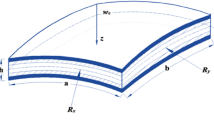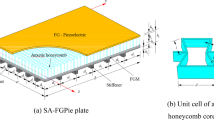Abstract
Constrained layer damping is one of the passive techniques to control amplitude of vibration of structural components. In the present work an attempt has been made to quantify and compare damping ratios of composite-rubber-composite sandwich beam with that of pristine composite beam having nearly the same flexural stiffness and range of frequency of vibration from 20 Hz to 100 Hz. Length and thickness of sandwich and pristine beams in order to have the same flexural stiffness and desired frequency range of vibration were specifically designed. The damping ratio of each sandwich and pristine composite beams were measured experimentally using logarithmic decay and half-power bandwidth techniques.
Similar content being viewed by others
Abbreviations
- t c :
-
thickness of composite
- t b :
-
thickness of rubber
- t :
-
total thickness of the beam
- b :
-
width of the beam
- w t :
-
total vertical deflection
- w b :
-
vertical deflection due to bending
- w s :
-
vertical deflection due to shear deformation
- P :
-
point load
- E :
-
Young’s modulus
- E r :
-
Young’s modulus of rubber
- E c :
-
Young’s modulus of composite
- G :
-
Shear modulus
- υ :
-
Poisson’s ratio
- L :
-
length of the beam
- A :
-
cross-sectional area of the beam
- α s :
-
shear correction factor
- I :
-
area moment of inertia
- G eq :
-
equivalent shear modulus
- G r :
-
shear modulus of rubber
- G c :
-
shear modulus of composite
- z :
-
distance measured from neutral axis
- k CRC :
-
flexural stiffness of sandwich beam
- ω :
-
circular frequency
- f :
-
frequency
- ρ :
-
density
- A n :
-
amplitude at time n
- A n+1 :
-
amplitude at time n+1
- ξ :
-
damping ratio
- Q :
-
quality factor
- f 1 :
-
lower frequency
- f 2 :
-
upper frequency
References
Kim, J. H., Shin, K. B., and Kim, J. S., “Optimum design on suspension joint parts of GFRP composite bogie frame with hshaped side beams for urban railway trains,” Int. J. Precis. Eng. Manuf., Vol. 13, No. 1, pp. 71–76, 2012.
Jeon, K. W. and Shin, K. B., “An experimental investigation on low-velocity impact responses of sandwich panels with the changes of impact location and the wall partition angle of honeycomb core,” Int. J. Precis. Eng. Manuf., Vol. 13, No. 10, pp. 1789–1796, 2012.
Nashif, A. D., Jones, D. I. G., and Henderson, J. P., “Vibration damping,” Wiley, pp. 10–12, 1985.
Sun, C. T. and Lu, Y. P., “Vibration damping of structural elements,” Prentics Hall PTR, pp. 160–192, 1995.
Kerwin, J. E. M., “Damping of flexural waves by a constrained viscoelastic layer,” The Journal of the Acoustical Society of America, Vol. 31, No. 7, pp. 952–962, 1959.
DiTaranto, R. A., “Theory of vibratory bending for elastic and viscoelastic layered finite-length beams, Journal of Applied Mechanics,” Vol. 32, No. 4, pp. 881–886, 1965.
Mead, D. and Markus, S., “The forced vibration of a three-layer, damped sandwich beam with arbitrary boundary conditions,” Journal of Sound and Vibration, Vol. 10, No. 2, pp. 163–175, 1969.
Rao, M. D. and He, S., “Dynamic analysis and design of laminated composite beams with multiple damping layers,” AIAA Journal, Vol. 31, No. 4, pp. 736–745, 1993.
Zhang, S. H. and Chen, H. L., “A study on the damping characteristics of laminated composites with integral viscoelastic layers,” Composite Structures, Vol. 74, No. 1, pp. 63–69, 2006.
Yu, S. C. and Huang, S. C., “Vibration of a three-layered viscoelastic sandwich circulate plate,” International Journal of Mechanical Sciences, Vol. 43, No. 10, pp. 2215–2236, 2001.
Marcelin, J. L., Trompette, P., and Smati, A., “Optimal constrainedlayer damping with partial coverage,” Finite Elements in Analysis and Design, Vol. 12, No. 3-4, pp. 273–280, 1992.
Zheng, H., Cai, C., and Tan, X. M., “Optimization of partial constrained layer damping treatment for vibrational energy minimization of vibrating beams, Computers and Structures,” Vol. 82, No. 29-30, pp. 2493–2507, 2004.
Moreira, R. A. S., Rodrigues, J. D., and Ferreira, A. J. M., “A generalized layerwise finite element for multi-layer damping treatments,” Computational Mechanics, Vol. 37, No. 5, pp. 426–444, 2006.
Moreira, R. A. S. and Rodrigues, J. D., “A layerwise model for thin soft core sandwich plates,” Computers and Structures, Vol. 84, No. 19–20, pp. 1256–1263, 2006.
Advani, S. G. and Sozer, E. M., “Process modeling in composites manufacturing,” Marcel Dekker Inc., pp. 56–58, 2002.
Merovitch, L., “Fundamentals of vibrations,” McGraw Hill Higher Education, pp. 95–117, 2001.
Author information
Authors and Affiliations
Corresponding author
Rights and permissions
About this article
Cite this article
Chennamsetti, R., Hood, A., Guruprasad, S. et al. Damping ratios of pristine composite beam and constrained layer damped composite beam of equal stiffness. Int. J. Precis. Eng. Manuf. 14, 1655–1660 (2013). https://doi.org/10.1007/s12541-013-0224-6
Received:
Accepted:
Published:
Issue Date:
DOI: https://doi.org/10.1007/s12541-013-0224-6




